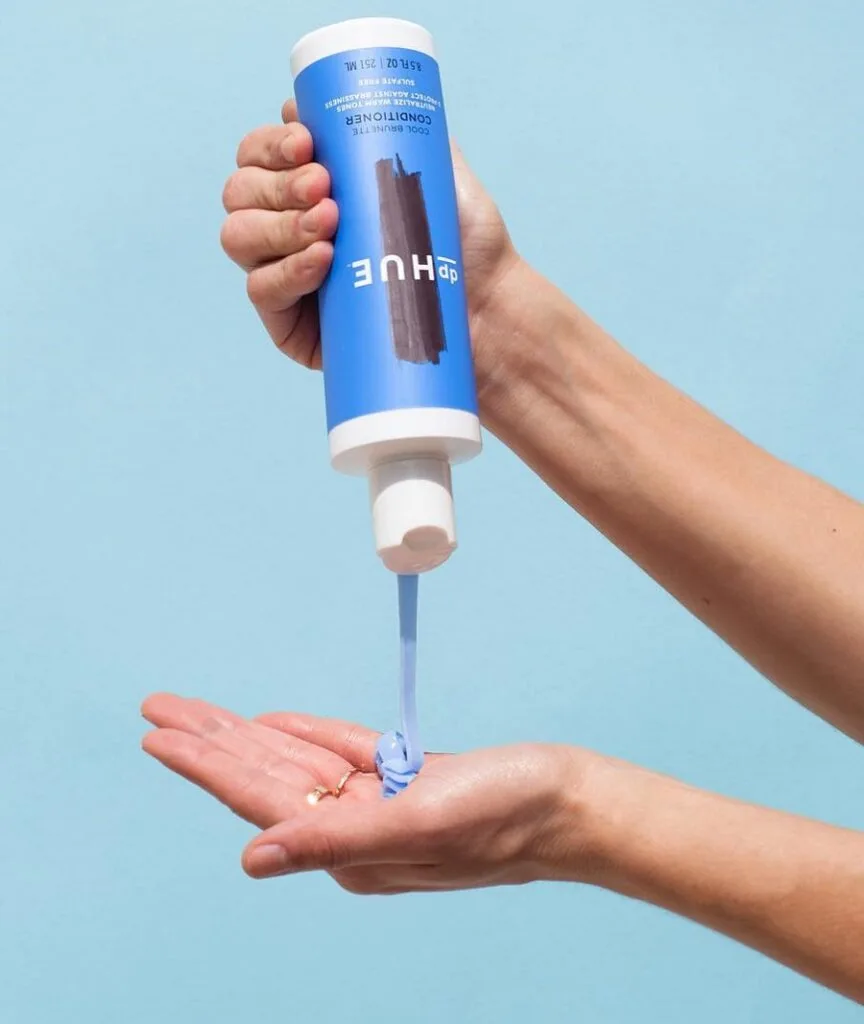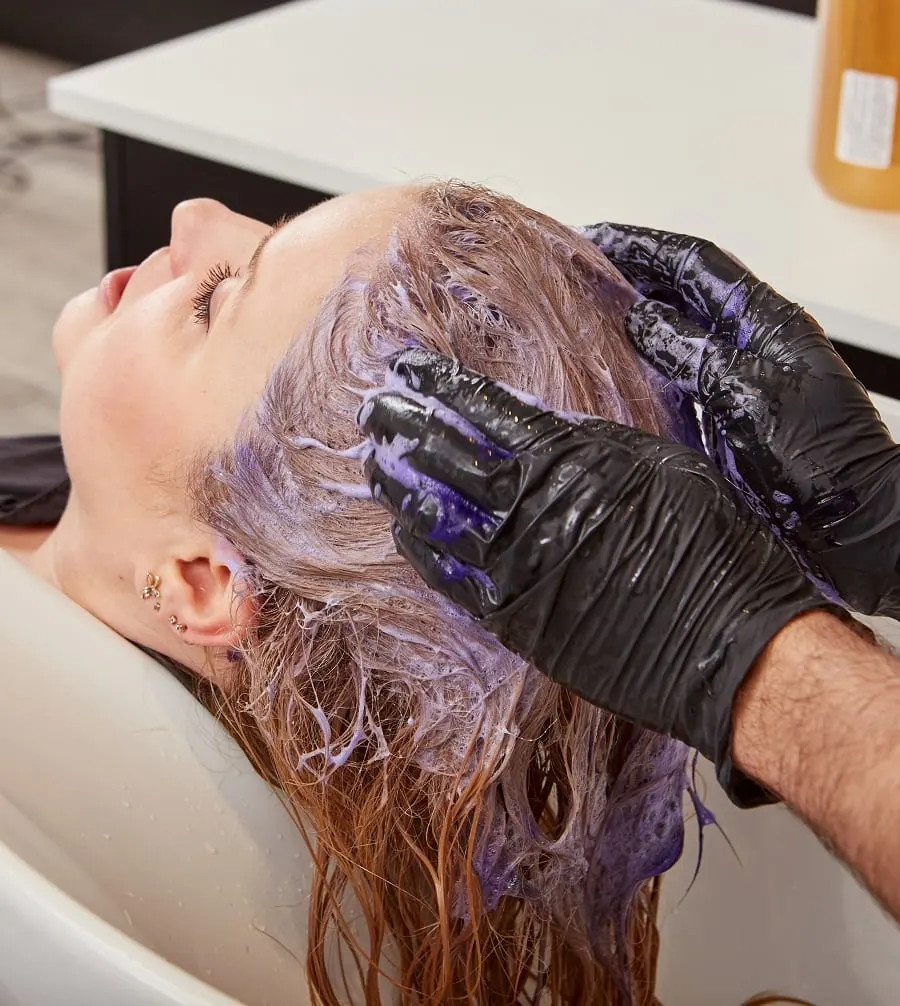Changing hair shades is the perfect way to level up your look. And toning shampoos like blue and purple are a blessing to protect your hair color from brassiness.
You can remove the yellow, orange, or red tones from your bleached or dyed hair at home using toning shampoos rather than running to the salon every few weeks.
But it’s important to know the differences between purple and blue shampoo as they are not interchangeable.
We’ve done an in-depth purple shampoo vs. blue shampoo comparison below so that you can choose the right one for your hair color.
What Is Purple Shampoo?

As the name suggests, purple shampoo contains purple pigments. When you use the shampoo, you deposit the pigments into your hair.
Purple pigments neutralize yellow and brassy tones from blonde, grey, or white hair and help to refresh the hair color and maintain a cooler, ashy, or platinum hue.
You can apply purple shampoo with a regular shampoo, leaving it on for several minutes to allow the purple pigments to tone the hair before rinsing it out.
What Is Blue Shampoo?

Just like the purple shampoo, the blue shampoo contains blue pigments meant to neutralize brassy undertones.
Blue shampoo is designed for individuals with brunette, brown, or light brown hair. It is more beneficial for those who have gone through bleaching or lightening processes.
The blue pigments counteract the orange and red brassy tones on brown hair that can develop over time, helping to maintain a cooler, more.
Using blue shampoo is similar to using regular shampoo. It is applied during the washing routine, allowed to sit for a few minutes to let the blue pigments work on neutralizing the warm undertones, and then rinsed out.
Differences Between Purple Shampoo and Blue Shampoo
| Aspect | Purple Shampoo | Blue Shampoo |
|---|---|---|
| Target Hair Color | Blondes, Redheads, Blonde Highlights in Brunette Hair | Brunettes, Salt and Pepper Hair |
| Color Neutralization | Yellow or brassy tones | Orange or red tones |
| Usage Frequency | Not daily; best used every third wash or once a week | Not daily; best used every third wash or once a week |
| Effect on Different Hair Tones | May not completely lift orange and brassy tones in brunette hair | Can be too harsh on blonde hair, potentially turning yellow undertones white or staining hair blue |
| Use for Color Maintenance | For maintaining ash or platinum blonde | For maintaining brown, or light brown hair. |
| Main Function | To neutralize yellow and lighter brassy tones | To neutralize orange and darker brassy tones |
Both shampoos utilize color theory to neutralize warm undertones in your hair. By simply looking at a color wheel, you can understand the uses of each toning shampoo.
Though blue and purple are right beside each other on the color wheel, blue and purple shampoos are used differently.
Purple is opposite to yellow. When you use purple shampoo, the purple will remove any yellow color present in your hair, making it cooler.
On the other hand, blue is the opposite of orange. This means blue shampoo cancels out any orange or brassy tones in your hair.
Still, if your hair turns warmer, it can be hard to figure out whether it’s leaning towards orange or yellow.
Purple Shampoo or Blue Shampoo: Which One Is Right for You?
To put it simply, blue shampoo is for brunettes, while purple shampoo is ideal for blondes. That’s because blonde hair tends to turn yellow over time, and brunette hair turns orange or red.
You should opt for purple shampoo in the following cases:
- If you have blonde hair of any shade
- If you have blonde highlights, balayage, or ombre hair
- If you have red hair
In contrast, blue shampoo is great for the following:
- If you have brunette hair with no highlights
- If you have salt and pepper hair
- If you want to turn your red hair into a neutral brown
How to Use Purple Shampoo and Blue Shampoo

There’s a specific way to use toning shampoos. While you can follow the instructions on the shampoo bottle, the following tips might help you get the most out of your blue and purple shampoo without damaging your hair:
#1. Determine Duration Based on Toning Needs
- Allow 2-3 minutes for regular maintenance.
- For excessive brassiness, extend to 15 minutes. Avoid over-saturation to prevent unwanted hues.
You can’t rush washing your hair, especially when you’re toning it. Shampoos with purple or blue pigment need time to interact with your hair so the shampoo can seep into it.
The longer you leave the shampoo in your hair, the more pigment will deposit. If you’re maintaining your hair, leaving the shampoo in for 2 to 3 minutes should do the trick.
If your hair has turned excessively brassy, you’ll need to wait 15 minutes before washing the shampoo out. But do not wait longer than that as purple shampoo may turn your hair purple or blue shampoo may leave a blue tone in your hair.
#2. Only Apply the Shampoo On The Ends
Typically, shampoo is used on the scalp to remove any build-up and clarify the hair follicles. However, that’s not the purpose of toning shampoos.
In contrast, you should apply toning shampoos to the ends of the hair only. If you have an ombre or balayage, focus the shampoo on the bleached hair. This way, you keep the damage to a minimum.
#3. Use Toning Shampoos Periodically
Undoubtedly, toning shampoos shouldn’t be a part of your everyday routine. Even a single use of purple or blue shampoo is enough to dry out your hair.
That’s because these shampoos don’t contain any hydrating ingredients. You also rub them on the ends of the hair, further damaging it. Naturally, you should only use purple or blue shampoo every third wash, or once a week.
The frequency may change based on your hair coloring technique. For example, use purple shampoo less often on balayage hair.
#4. Dilute the Shampoo
If you’re too worried about the purple or blue shampoo damaging your hair, you can dilute it using any moisturizing shampoo or conditioner you have. Mix the toning shampoo with the conditioner in a 2:1 ratio, and apply it as you normally would.
This can be particularly helpful if your hair isn’t brassy but you’re looking to maintain the color. Also, diluting the shampoo ensures it doesn’t stain your hair or significantly alter its shade.
Frequently Asked Questions
Here are some common questions regarding the use of purple and blue shampoo.
How to Make Toning Shampoo at Home
Knowing all the ingredients of your shampoo might ease your mind. Luckily, you can make your toning shampoo at home, whether it’s blue shampoo or purple shampoo.
All you need to do is mix a small amount of your favorite shampoo with a couple of drops of gentian violet. Then, you’ll have a way of toning your hair if you’re in a pinch!
The difference between purple and blue shampoo is straightforward. As their names imply, each shampoo has a different color pigment.
Purple shampoo is best for blonde hair, counteracting yellow undertones. In contrast, blue shampoo works for brunettes, as it cancels out orange shades.
Can Brunettes Use Purple Shampoo?
Purple shampoo can still be beneficial to brunettes. That’s why brunettes with blonde highlights should use primarily purple shampoo, as blue shampoo can damage their streaks.
That said, you shouldn’t expect purple shampoo to completely lift all the orange and brassy tones from your hair, as it’s less potent than blue shampoo. So, if your hair needs serious toning, you should opt for blue shampoo.
Can Blondes Use Blue Shampoo?
Blondes should stay away from blue shampoo, even if it’s their last option. That’s because blue shampoo might be too harsh on blonde hair. It can turn the yellow undertones white, or even stain your hair blue.
Trending Topics
